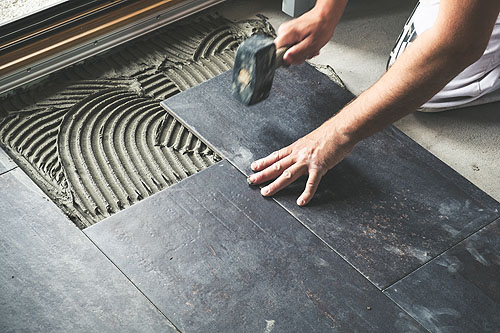Home Flooring Trends for 2019
What types of flooring do homeowners prefer most in 2019? From materials to colors to patterns, these are the types of floors you should consider for your next build.
Blanched/bleached wood floors: Instead of glossy brown stains, many modern homeowners have taken a liking to the white-washed look of bleached flooring. These floors consist of woods that have been bleached or “blanched.” The look is created by applying chemicals that eliminate much of the artificial stain or dye coating the wood. What’s left is an ashy, white-washed appearance that leaves the wood grain visible. The flooring still boasts the charm and beauty of natural wood, while maintaining a soft, stylish look that meshes well with contemporary design elements.
Vintage black and white tiles: Evoking the style and feel of yesteryear, vintage design elements have become a popular flooring trend for modern homeowners. Instead of using the antiquated black and white tiles you might find in a historic home, today’s designs showcase smaller, luxurious tiles with bold textures and graphic patterns. This adds a unique twist to vintage flooring, while still capturing the nostalgia of decades past. The style combination blends great with contemporary furniture and design features in the kitchen and bathroom.
Graphic tiles flooring: Today’s homeowners are more willing to view their flooring as a sort of art canvas, where they can showcase graphic designs and artful patterns. Thanks to advancing technology, modern manufacturers can replicate just about any image and apply it to floor tile. You can get everything from repeating patterns to tiles that form large designs in a jigsaw fashion. In most instances, it’s best to tone down complex tile flooring graphics by choosing monochromatic colors. If you feel especially daring, however, you can get these types of designs in multicolored patterns.
Fumed wood floors: To achieve the desired finish, traditional wood floors undergo some form of staining. On the other hand, some wood floors get their grain and color through a process called fuming. During this process, the wood is placed inside a chamber where it is exposed to airborne ammonia. As the wood reacts with the chemical, it changes color, with similar wood pieces having varying hues based on the atmosphere inside the chamber and the environment outside. In general, fuming draws out natural wood grains while providing rich dark color tones. The final aesthetic looks far more luxurious than traditional stain. Just bear in mind you can’t get this effect by applying liquid ammonia to wood, as this will result in disappointing aesthetics, while also damaging the wood fibers.
Distressed concrete flooring: Although it’s been around for decades, the distressed floor aesthetic has recently gained in popularity. Traditional distressed wood flooring gains its rustic look by undergoing an artificial aging process, where the flooring is hand-scraped, kerfed and swirled until every wood plank attains the desired look. With distressed concrete, flooring goes through an artificial process that minimizes the polished look in favor of a worn-looking patina. Although it can be skillfully integrated into any design type, distressed concrete flooring works best in homes that have a contemporary or industrial style.
Learn how you can protect your business and add valuable selling points to your new builds with 2-10 Structural Warranties.








